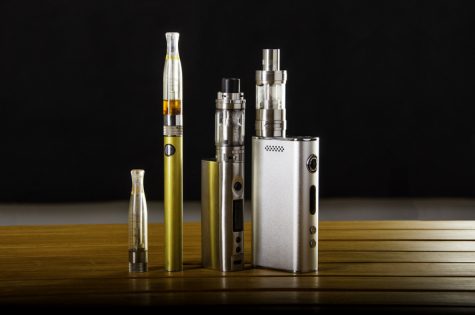E-cigs attempt to decline
October 10, 2019

Seen as the largest epidemic of generation Z, vaping has taken every teenager’s world by storm and has caused parents throughout the nation to be extremely concerned. Electronic cigarettes have reached a popularity so high, that the Center for Disease Control recently made a statement stating the eminent health concerns involved with the use of electronic cigarettes. After all the bad news spreading around social media, what are college students thinking about getting their nicotine fix?
As more and more cases turn up of teens having lung issues due to vaping, the concern for lasting health risks increases as well. The toxic chemicals used in the liquid is giving victims respiratory issues ranging from pneumonia to tissue damage (also known as popcorn lung).
Electronic cigarettes started as a target for the long-term smoker looking to quit. They provided a “less toxic” and “cheaper” alternative to cigarettes that had regulated amounts of nicotine additive to eventually quit. While we all know only the cool kids smoked cigarettes, word of these techy, flavorful chunks of metal grew immensely in popularity with younger generations. It is now said that first-time nicotine users are not introduced with chewing tobacco or cigarettes, but instead e-cigarettes.
With approximately 80% of cases being under the age of 35, this health concern is targeted at the millennial generation. Companies like Juul, Vuse, Smok and Sourin all have product lines with nicotine-based products. Most ingredients are not regulated by the FDA, and there is no prolonged study of health affects due to e-cigarettes.
So, why don’t people quit? Social media highlights videos of teens throwing e-cigs in garbages, lakes, and even off bridges, but vaping companies have yet to see a decline in sales.
“I’ve heard about the health risks, but vaping has not caused me any health problems,” explains Sam Johnson, University of Minnesota student. It seems that people have not yet been convinced.
Recently, the U.S. government has begun to ban the sale of flavored e-cigarettes in hopes that it reduces the likes of young teens entranced by their exotic flavors. Since then, companies like Juul have pushed further to have advertising campaigns showing smoking in a social setting.
Currently, there have been eighteen deaths in the United States linked to vaping. This statistic, as scary as it is, is not staggering enough to get teens to quit.
“I feel like there are other things out there that are worse for me,” says Patrick Newell, University of Minnesota student. The vaping industry, valued at 22 billion dollars, has yet to see a hit be taken from their profits since the deaths have occurred.
The next step for electronic cigarette companies is primarily to receive certification from the FDA noting that their products are safe for use, but this seems to be far from existent after the recent news. Still, the market is projected to grow over 24% in the next five years seeing that less people are going to conventional cigarettes each week.
“I think cigarettes are gross, but the minty flavor of e-cigs is much more appealing,” says Danny Johnson, University of St. Thomas student.
Teens are spending upwards of $30 per week on tobacco products. Juul, the most popular nicotine product in the market, charges from $16-$32 for their product that often doesn’t last more than a week.
While many parents are concerned about the health effects of vaping, the positive note is that less teens are smoking cigarettes. With that said, the gateway is wide open to other addictive premises and is a huge concern to activist groups like KnowTheRisk, a group started by the surgeon general. Efforts have been put forth to get kids to quit, but the combination of marketing campaigns, limited evidence, and popularity seem have a firm grasp on the next generation of America.













